The Queen Victoria Market has had a colourful and sometimes controversial history. The site has been a cemetery, a livestock market and a wholesale fruit and vegetable market. Each of these operations has its own history and an element of controversy.
The Queen Victoria Market was officially opened on 20 March 1878, a range of markets having operated from the site in varying forms prior to that date.
Melbourne remains a Market town with many large municipal markets including South Melbourne, Prahran and Dandenong Markets. However, Queen Victoria Market is the largest and most intact of all Melbourne’s great 19th century markets.
Take yourself on our Self-guided Heritage Trail
Our History

The Market is located on the traditional lands of the Wurundjeri People of the Kulin Nation, and forms part of the wider Aboriginal cultural landscape, including nearby landmarks such as the former Elizabeth Street creek and Flagstaff Hill.
We acknowledge the Wurundjeri People’s ongoing connection to Country and pay our respects to their Elders past and present.

Between the years of 1837 and 1854, much of the land on which the Queen Victoria Market now stands was the site of Melbourne’s first official cemetery, which housed the remains of an estimated 10,000 early settlers, including a specific Aboriginal burial area which is recognised as an Aboriginal historic place.
Today, the cemetery area is covered by the Market’s open air car park and some Market sheds. Part of the structure of F Shed includes a brick wall built in the late 1800s to mark the northern edge of the cemetery boundary which still remains.
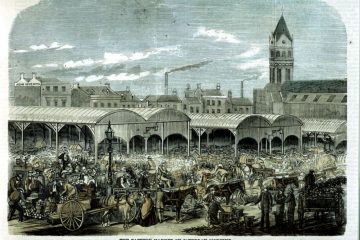
In 1841, at the corner of Little Collins and Exhibition streets, about three quarters of an acre of the reserve which remained next to the building used for a ‘female penitentiary’ was designated as a future site for a general market by the Market Commissioners. At the time, unofficially, it was used as a hay and corn market. At the request of the Council, it was proclaimed a general market site on 1 August 1846, and immediately became the official hay and corn market in place of the one which had operated on the site where St. Paul’s Cathedral now stands.
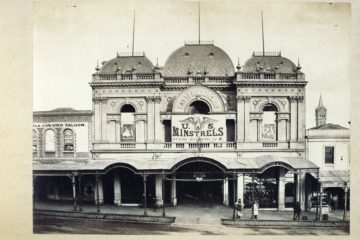
Melbourne has always been a Market town. Its residents have always had a fascination with Markets, and this tradition continues even today. The Melbourne City Council was originally established in 1842 to manage the City’s many markets, of which one was Queen Victoria Market.
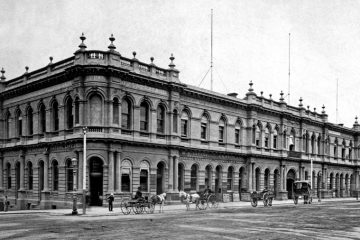
This was Melbourne’s first official fruit and vegetable market, established a mere 6 years after settlement began. In its early years, the Western Market was a general market; in the end, a wholesale cased fruit market. It lasted for ninety years, taking up the city block bounded by Market, Collins and William Streets and Flinders Lane, a site now occupied by the AXA Centre.
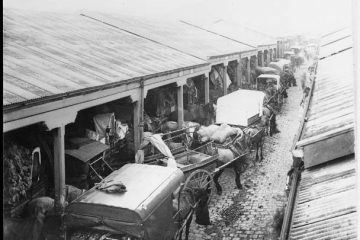
The Lower Market (bounded by Elizabeth, Victoria, Queen and Therry Streets) is the oldest part of the Market. It was originally set aside in 1857 for a fruit and vegetable market due to over-crowding and congestion at the Eastern Market but the location was unpopular and the market gardeners wouldn’t use it. Instead, it was used as a livestock and hay market until it was permanently reserved as a Market in 1867.

The Upper Market (bounded by Queen, Victoria, Peel and Franklin Streets) was not originally reserved as a market but had a number of other uses including a school and drill hall. Its predominant use, however, was as Melbourne’s first cemetery. Construction of A-F sheds began in 1877 at the northern-most edge of the Market. This site was chosen because it contained the school, drill hall and the least-used section of the cemetery.
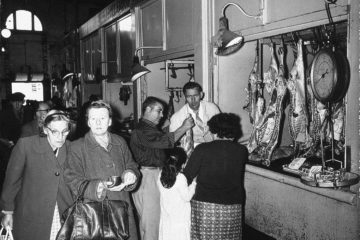
One of the most intriguing stages in Queen Victoria Market’s history was during the 1960s, when the Market was associated with the infamous “Honoured Society”. Indeed, much of the innuendo and rumour surrounding the Market today can be attributed to this period.
It all began in 1960, when the complaining of suspicious growers unhappy with the handling of their consignments resulted in a Royal Commission being established to investigate price fixing at the Wholesale section of the Market.
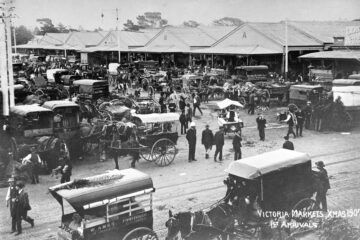
The separation of the Wholesale Market from the Retail Market lead to a plan to redevelop the Queen Victoria Market site into a trade centre, office and hotel complex in the 1970s. However, public outcry prevented this and resulted in the Market being classified by the National Trust. Later, the Market site and its buildings were listed on the Historic Buildings Register. Queen Victoria Market survives today as one of the largest and most intact examples of Melbourne’s great nineteenth century markets.

The hall was remodeled in 1975, which included access to hot water, doubling the size of each stall to allow for the installation of cool rooms, the addition of a depot for receiving deliveries of meat and an overhead rail system on which meat can be pulled to any stall in the building (which is still very much in use today).

In October 2013, the City of Melbourne announced the largest investment in its history to renew the Queen Victoria Market and surrounding precinct. Since then, significant work has been undertaken with traders, the community and key stakeholders to plan for the careful revitalisation of this seven-hectare site. The 2015 Master Plan identified the vision for the renewed precinct with several projects completed since then. Key projects underway include shed restoration, provision of essential trader facilities and sustainability measures. The precinct will be revitalised with a new 1.75 hectare public open space, affordable housing and community facilities. Visit City of Melbourne for full details of the Queen Victoria Market Precinct Renewal program.

In 2018, the Market was added to the National Heritage List based on two key heritage values – its links to the early colonial population of Melbourne and its ability to demonstrate the principal characteristics of a 19th century metropolitan produce market. The listing is significant as recognises the important role and value of the Market as the largest intact 19th century Market in Australia and the site of Melbourne’s first cemetery. The City of Melbourne’s renewal will complement the National Heritage List status by protecting the values, history and traditions that underpin the Market’s heritage recognition. The market has also been listed on the Victorian Heritage Register since 1989.
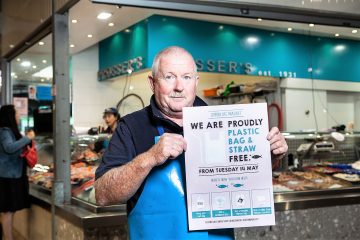
In May 2019, Queen Vic Market banned single-use plastic bags and straws ahead of the Victorian Government’s planned legislative ban in November 2019. The Market is committed to sustainability and continually improving our environmental impact, and going plastic bag and straw free was a major step in reducing the amount of plastic at the Market.

The most significant restoration of the Market’s open-air sheds in 40 years commenced in May 2020. A key part of the market renewal, the City of Melbourne is investing $30 million on conservation, restoration and structural works to secure the sheds as the unique backdrop of the market experience. Many of the sheds have been in continuous use since the Market’s opening in 1878 and have experienced impacts from weather along with general wear and tear. The restoration works will ensure characteristics that reflect the historical use of the market are retained while important structural works will improve stability, safety and prevent future damage. The market remains open throughout the works which will be completed by 2022.

